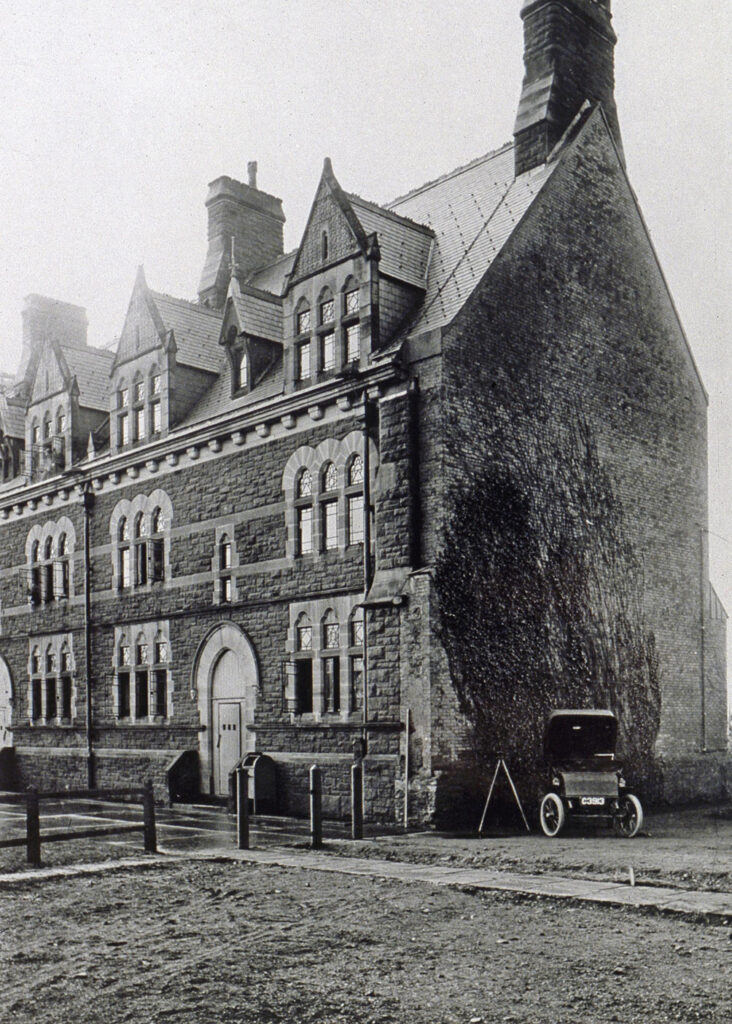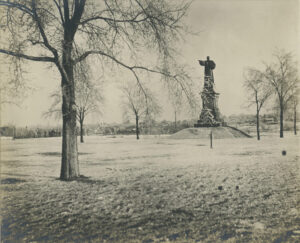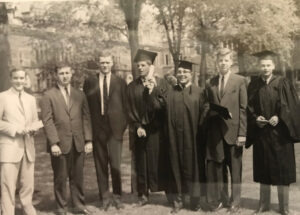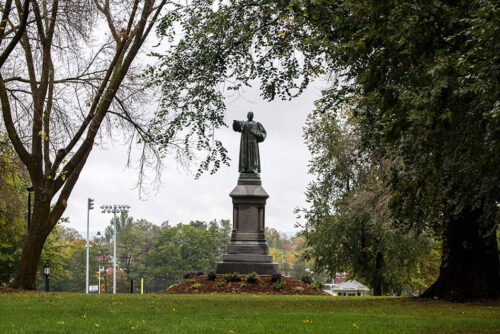Illuminating Trinity
The College’s Bicentennial calls for celebration, introspection, dialogue, and storytelling
By Kathy Andrews
Two hundred years ago, Episcopal Bishop Thomas Church Brownell and fellow petitioners successfully presented a proposal to the state’s legislature to establish a second college in Connecticut, with Yale University being the first. In that place and time, Hartford in May 1823, the group of petitioners was considered truly representative of a broad swath of society.
“These men represented a wide spectrum as to place of residence, politics, occupation, and ecclesiastical connection. . . . Among them were clergy, merchants, attorneys, government officials, Episcopalians, Congregationalists, and a Baptist,” wrote Glenn Weaver in “A Dream Is Realized,” the second chapter of his 1967 book, The History of Trinity College (Volume One). The heterogeneity of perspectives among the founders of Washington College—renamed Trinity College in 1845—is a pertinent starting point for contemplating Trinity at 200. As the College enters its third century, members of the Trinity community are taking time to thoughtfully consider their educational institution, from its inception through decades of historically significant events.
A focus of the yearlong Bicentennial celebration—with the theme “Committed to the future since 1823”—will be on sharing a breadth of viewpoints and voices, including examination of and dialogue about how Trinity and its home city have evolved over time and about future commitments Trinity may make. At its heart, this celebration is anticipated to share, in a variety of ways, the perspectives of Trinity people—those who have lived, studied, educated, collaborated, debated, worked, played, laughed, cried, grown, and made meaningful connections at the College.
Interplay of Voices
“When I think about the founding of the College as this interplay between different voices, I think it weaves a powerful story about everyone’s individual stories intertwining into Trinity as a place that has these roots but has broadened and brought in more stories over time,” says Elizabeth Preysner ’13, who holds a B.A. in English and Hispanic studies, a master’s in English literature from the University of New Hampshire, and a master’s in divinity from Yale Divinity School. Both Preysner’s husband, Samuel Ingraham ’13, and her mother, Yolanda Sefcik Preysner ’79, are Trinity alumni.
Trinity stories and the value of the liberal arts have been on Preysner’s mind as she participates on two Bicentennial committees: the 200 Stories Committee and the Liberal Arts Celebration Committee. An associate chaplain, teacher, and coach at St. Andrew’s School in Delaware, Preysner says, “I am a huge proponent of the liberal arts. And I see that in terms of the body, mind, and spirit, which I felt was very true of my experience at Trinity as an athlete, a student, and through my involvement in the Chapel.” She says she joined the committees because “I was curious to see . . . what does a Bicentennial celebration look like, and how does a college go about marking a moment like this? I was particularly curious because Trinity is a place that is important to me and a place that over the years has—as all institutions do—grappled with questions of identity and inclusion and who we are.”
Reagan Flynn ’23, a member of Trinity’s Bicentennial Class of 2023, also has been thinking about the Bicentennial. A political science major, Hispanic studies minor, and senior admissions associate, Flynn says, “Some conversations I’ve had with fellow students have been about how remarkable it is that it’s been 200 years but also about who has been able to be educated at Trinity for 200 years . . . women only celebrated 50 years at the College a few years ago; people of color also were not attending this school for so many of those 200 years, so I think about that. We are celebrating this incredible milestone, but it’s important to think about how the school has changed over 200 years and ask how we can continue to make changes so that the next 200 years are more inclusive and accepting.”
Associate Vice President for Advancement Dwayne D. Busby is involved in planning the June 9–11 Alumni Bicentennial Celebration—coinciding with Reunion for class years ending in 3s and 8s—as well as other events, such as the Bicentennial Fall Weekend October 13–15. Busby says he finds it fascinating to speak with alumni and students about their Trinity experiences in his role as co-chair of the People Celebration Committee. “We have opportunities to hear what Trinity meant to our alumni. Of course, up until the late ’60s, Trinity was all male, so what did that mean at Trinity in that time? And in the ’70s, when the first women came on board, what did it mean to Trinity then and how did it impact the women’s lives, being the pioneers in making Trinity a coed college, and later, when they left Trinity?
“Then you look more recently at our students who went through the pandemic and the social upheaval in the United States and how they persisted in benefiting from their education,” continues Busby. “But the education wasn’t just in the classroom. It happened online, learning how to communicate and socialize virtually. So, we have all of these opportunities to share the stories and experiences of individuals in an intergenerational way, thanks to participation from our alumni and students, and it will really personalize and humanize the Bicentennial.”
Unprecedented Opportunity

When considering a theme, the Bicentennial Steering Committee—with considerable input from the broad Trinity community—debated the many dynamics of the collective experience that felt true to Trinity. “We could have focused on the depth of our academic legacy or our friendships,” says President Joanne Berger-Sweeney. “Rather, we decided to focus on our collective history and future as agents of transformation and our potential to contribute to the public good. How we engage is only as deep as the actions we take. We are taking stock of what it means to make commitments and what we are prepared to do to bring about a stronger Trinity and a better world. Leadership requires us to go beyond intentions to turn ideas and aspirations into reality. This is how we wanted to orient this powerful community toward our third century. After all, we only turn 200 once.”
Philip S. Khoury ’71, H’21, former vice chair of the Board of Trustees and co-chair of the Bicentennial Steering Committee, adds, “There are not a lot of institutions in this country that can claim 200 years of experience. More importantly, Trinity has been delivering excellence to its students all these many years through its high-quality liberal arts programs, from the humanities to the sciences. Trinity is unique in some ways; for example, it is one of the few liberal arts colleges that managed to create an Engineering Department within it, and that is a huge asset.
“I mention this,” Khoury says, “because Trinity has been looking toward the future for many, many years. And this celebration is in part to reflect on our history, but in large part, it is to point in the direction that Trinity wishes to head in the next 100 or 200 years. That is what makes this so exciting to me—an opportunity not just to reflect on the past but to help develop a vision for the future.”
Also co-chairing the Bicentennial Steering Committee is Trustee Kelli Harrington Tomlinson ’94, who says, “The Bicentennial is an unprecedented opportunity for alumni, families, and students—for the entire Trinity community—to participate. It is a moment to reflect upon the impact that Trinity has had not only on their lives individually but in its collective impact through the myriad contributions our alumni have made across the entire spectrum of human endeavor.
“Through those reflections, we hope also that they will recognize the value, importance, and urgency of investing philanthropically and in continuing the College’s mission through our current campaign,” adds Tomlinson.
Reflection and Dialogue
The co-chairs of the core campus committee for the Bicentennial—Hellen Hom-Diamond, Trinity’s vice president for strategic marketing and communications, and Mitch Polin ’96, associate dean for curriculum—look forward to many avenues for storytelling, memories, and dialogue.
“How can we best honor the past, reflect the present, and lead the future? By celebrating the richness of our collective history and offering opportunities to participate, we hope to engage as many people as possible,” says Hom-Diamond. “Some people will want to simply enjoy time together, and others hope to be part of thought-provoking conversations. We hope to be as inclusive and accessible to as many alumni as possible, no matter where they live,” adds Hom-Diamond, noting that monthly emails and the Bicentennial website will regularly offer new content and updates about event details, including special announcements about Trinity and updates on speakers, panelists, and performers.

Hom-Diamond explains, “The premise of the 200 Stories digital storytelling project is that the last written history book about the College was published in 2000 [Trinity College in the Twentieth Century: A History, by Peter J. Knapp ’65 and Anne H. Knapp], so we have 23 years of living history to capture. So, this is a way to encourage alumni to share their perspectives and connect and engage with Trinity and all the communities special to them within the larger community.”
Polin says he looks forward to the two planned Bicentennial symposia, November 14, and February 28. “I think that each symposium plays a key role in, ideally, moving the community closer to being able to identify, debate at times, but state our institutional commitments to the future, to establish primary questions, to ideate around goals, and to initiate broad, collective participation,” he says.
The first symposium, “Memory, Presence, and Possibility,” will feature keynote speaker Claudia Rankine—renowned poet, MacArthur “genius grant” recipient, and Frederick Iseman Professor of Poetry at Yale—who will look at Trinity’s past, present, and future identity, both internally and as part of the Hartford and global communities. The second symposium, “Reflection and Action,” will examine the evolution and flexible strength of Trinity’s liberal arts education. It is anticipated that keynote portions of the in-person symposia also will be available online.
Virtual Tour, Trinitiana, And More
Two Bicentennial projects sure to be of interest to all members of the Trinity community are slated to launch early in the celebration: the Virtual Bicentennial Tour and the wiki-style Encyclopedia Trinitiana.
Carlos Espinosa ’96, M’98, director of the Office of Community Relations and Trinfo.Café, is leading the group developing the Virtual Bicentennial Tour, which will feature 3D photography and video. Espinosa, who co-chairs the Places Celebration Committee, says he is excited about the ways in which the virtual tour will showcase some of Trinity’s most iconic spots on campus.
“The Bicentennial tour will be an especially immersive experience, including several stops with a 360-degree panoramic view or a 360-degree video. For the Long Walk, for example, we’ll be doing a 360-degree video around the Northam Towers area to capture the entire Main Quad, from Raether Library on one side all the way to the Chapel on the other.” The virtual tour also will include “hot spots”—embedded content such as videos, images, audio files, or a personal story or welcome from a member of Trinity’s community about that location.
Recognizing that not all alumni will return to campus, the goal, says Espinosa, is to create many links between different platforms housing Bicentennial content—such as the virtual tour, the Bicentennial website, the 200 Stories digital storytelling project, an expanded Trinity history timeline, and the online Encyclopedia Trinitiana (pronunciation: Trin-it-tee-AHN-ah). Library staff began thinking of compiling this resource in late 2021, according to Eric Stoykovich, College archivist. From the mission statement set to be part of Trinitiana’s “About” page, its goal is “to highlight events, places, and people within the long history of the College and to provide a platform for exploring Trinity through many different lenses.” Stoykovich notes that the collaborative project involves several library and digital learning professionals and student workers, and the hope is for Trinitiana to continue to be a resource beyond the Bicentennial.
Among highlights of the year’s events also will be the 1823 Series, to include a Bicentennial carillon concert and picnic on July 12; regional Bicentennial symposia and events; athletic contests and receptions, with each athletic team having a designated 1823 Series game; and, at Cinestudio, a series showcasing six decades of on-campus movies. All 1823 Series events are free and open to everyone.
Bicentennial Committee members—see the full list on the Bicentennial website www.trincoll.edu/Bicentennial—have been hard at work planning and organizing a full year of story sharing and activities. Their efforts will make possible an abundance of events both cerebral and celebratory and a range of opportunities for all Trinity community members to connect, reunite, and take part in a special experience.
“There are thousands of great stories that we hope to be told through this Bicentennial year,” says Polin. “There will be a variety of opportunities to do that, from the Alumni Bicentennial Celebration to the 200 Stories project, to the symposia, to regional events, to other pop-up events that will take place throughout the year. It’s critical that this is a collective experience and an opportunity for all of these great stories to illuminate not only why the Bicentennial is important but also why Trinity is critical—regionally, nationally, globally—and why it will continue to be so for the next 200 years.”
For more on the Bicentennial, including an up-to-date schedule, please visit www.trincoll.edu/Bicentennial.

Click to enlarge
What is your best memory from the Main Quad?
Stan Marcuss ’63
Graduation day in 1963: Ted Stier, Charlie McGill, Bob Kirk, Eddie Roberts, Rick Nygard, Stan Marcuss (class president), and Stone Coxhead
Scott Reynolds ’63
“For many years, the Main Quad was the location of one of Trinity’s most important student ceremonies, the Medusa tapping. Founded in 1892, the Medusa became the highest nonacademic honor at Trinity. The seven ‘retiring’ senior class members selected their replacements and on an early May evening emerged single file from the Chapel, proceeding to the Main Quad, where the student body had assembled. The Medusa weaved through the crowd until all the new members had been located. Then, one by one, the old members tapped the new members and disappeared into the Chapel. As the society evolved, it assumed enforcement of regulations and the judicial function. By the late 1960s, its members as well as the student body grew uncomfortable with the Medusa’s dual role of policing and conducting student trials. In the turmoil of student activism of the late 1960s, the Medusa disbanded itself.”
Alex Achimore ’71
“Spring 1969. One of the first 17 women to attend Trinity used to sit under an elm tree a few feet inboard of the pavement of the Long Walk to read and talk with friends who stopped by—she had a lot. Her real name was Starr, but we, at least the particular circle I was in along with Kit Briggs ’69, Bill O’Reilly ’71, Russ Kelly ’71, and Chuck Shouse ’71, also called her ‘the Quad Queen.’ It was Saturday afternoon of a big weekend, The Byrds were playing in the field house that night, and as usual I didn’t have a date. I didn’t think she would be dateless, too, but I nervously sat with her for a bit and finally asked her to go the concert with me. So began a five-year romance and many decades of friendship until her death 10 years ago.”
Eileen Kern ’81
“Hanging out with friends, enjoying how much Trin students loved being outside.”
Allyn Magrino ’85
“During Hurricane Gloria in the fall of 1985, we were all told to stay in our rooms to be safe. However, the majority of campus was out on the Main Quad in the rain, sliding down the muddy hill next to the Chapel, and generally having a blast while someone was blaring the song ‘Gloria’ by Van Morrison out the window of one of the quad dorm rooms. I was a freshman and remember thinking, ‘Wow, this place is great,’ and I was happy to see as the years went on that this wasn’t a one-time thing but representative of the joie de vivre that was such a big part of my Trinity experience.”
Jeffrey Coleman ’01
“Barbecues, walking along the Long Walk with friends, sledding down the hill with trays from the dining hall when the College was closed for a blizzard, clambakes during Reunion Weekend.”
Josh Frank ’16
“I have a lot of memories of the quad. The best one was perhaps just seeing students relax and enjoy the spring weather.”
Brendan Clark ’21
“Among my fondest memories of the Main Quad was my time spent working with the Tripod. With the advent of computers, the Tripod staff could work remotely and expand beyond the student newspaper’s humble offices in the basement of the Jackson dormitory (earlier generations may recall that the Tripod had once been located in Seabury and in the basement of Mather). We (in my early years, Trip Slaymaker ’18, Gillian Reinhard ’20, and Alex Dahlem ’20) would regularly set up, with spring weather in tow, on the quad for several hours of editing and layout. While less thrilling than fun collegiate antics, the joy of seeing things in blossom and emerge from the bitter cold was certainly inspiration to carry on with our work reporting on campus events.”

